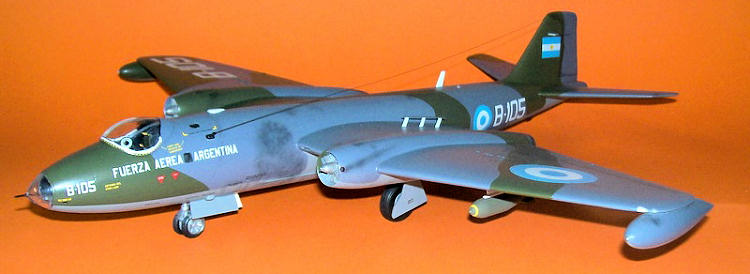
Classic Airframes 1/48 Canberra B.2 (Export Version)
| KIT #: | 4126 |
| PRICE: | CAD $47.95 |
| DECALS: | Several options |
| REVIEWER: | Pablo Calcaterra |
| NOTES: | Aztec 48-027 decals |

| HISTORY |
After a successful tour around
 When in 1967
negotiations were moving forward these were again cooled down as tensions
between
When in 1967
negotiations were moving forward these were again cooled down as tensions
between
Finally the transaction took place in 1969 when
|
msn |
Ex RAF |
|
|
HP182P |
WJ616 |
B-101 |
|
71233 |
WJ713 |
B-102 |
|
71234 |
WJ714 |
B-103 |
|
SH1656 |
WH913 |
B-104 |
|
71165 |
WH702 |
B-105 |
|
HP176P |
WJ609 |
B-106 |
|
71203 |
WH727 |
B-107 |
|
SH1613 |
WH886 |
B-108 |
|
?2373 |
WH875 |
B-109 |
|
HP186B |
WJ619 |
B-110 |
|
71416 |
WT476 |
B-111 |
|
71371 |
WJ875 |
B-112 |
|
The “lost” lot (purchased in 1981 but withheld and never
delivered by |
||
|
SH1657 BMk2
to Mk92 |
WH914 |
? |
|
XH583 TMk4
to TMk64 |
XH583 |
? |
During 1971 and with the availability of the two trainers crews started to be
trained in the country while the Squadron was gaining proficiency. The Squadron
was based in BAM
The first loss of a plane happened when B-103 crashed in 1971 during a touch and
goes training exercise but luckily the crew survived albeit with injuries.
During 1978 tensions again increased and
The next plane to be lost was B-109, which crashed during a summer storm in
1979. The pilot survived but the navigator perished.
1982
Now
the timeline brings us to 1982 when the conflict between 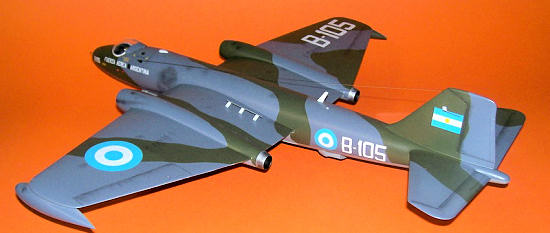 Mk17 bombs
started. On April 21st four planes
(B-104/B-105/B-109 and B-110) flew over the
Mk17 bombs
started. On April 21st four planes
(B-104/B-105/B-109 and B-110) flew over the
I
am going to focus on the missions that B-105 flew. I am also going to describe
other missions where B-105 might not have been involved but are nevertheless
significant or interesting. Please note that there were more OF and missions
than the ones I am writing about.
April 25th
On this date Operation Paraquat started (retake of
May 1st
The
fighting war really started around the
OF 1111: Call sign RUTA with B-105 (Capt Nogueira
/ Sanchez), B-108 (Capt Rodino / 1st
Lt Dubroca), B-109 (1st Lt Lozano /
Lt Cooke). They took off from Trelew and flew South East but they did not know
that in their path HMS Yarmouth and Brilliant were
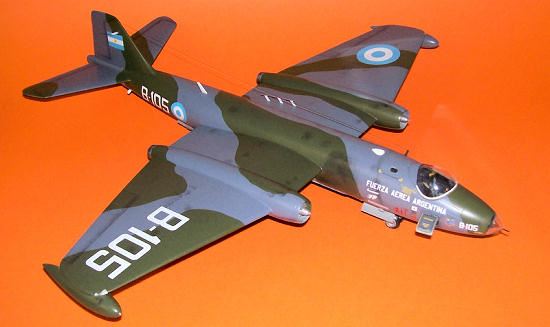 chasing the
Argentine submarine
chasing the
Argentine submarine
OF 1117: Call sign RIFLE with B-102 (Capt Baigorri / Mj Rodeyro), B-110 (1st
Lt Gonzalez / Lt. De Ibanez) and B-104 (Capt. Garcia Puebla / 1st
Lt Segat). They listened on their radio the conversation and shouts given by
RUTA during their engagement. RIFLE was flying in clouds and the tension was so
high that they did not realized they legs were shaking or that the seat was
uncomfortable or even that they were sweating a lot! Garcia
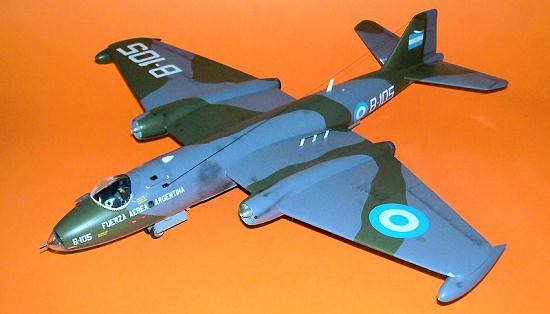 From now on
all attacks were to take place at night. Also a change to BAM Rio Gallegos as a
base to launch the attacks was implemented. This decision left the planes 1,200
km away from Trelew.
From now on
all attacks were to take place at night. Also a change to BAM Rio Gallegos as a
base to launch the attacks was implemented. This decision left the planes 1,200
km away from Trelew.
Once the British troops had landed on the Islands in San Carlos on May 21st
the first mission took place on May 26th
May 26th
OF ?: call sign ? with 4 x Mk17 bombs each. B-104 (1st
Lt Mauad / Siri),
B-105 (Capt. Bredeston / Capt. Sisco / Piazza) B-108 (Freijo
/ Marin). After flying 180 nm the attack was called off due to lack of
visibility.
May 27th
OF 1240 : call sign Odin with 4 x Mk17 bombs each. B-101 (Mj Vivas / Capt
Escudero) and B-104 (Capt Freijo / Capt Marin). Even though B-105 was not
involved in this mission I want to mention it because it was the first effective
bombing mission. Flying very low and in high winds, the couple of bombers flew
from South to North San Carlos Strait (Falklands Sound). After passing Darwin on
their right they dropped their wing tip tanks and accelerated. They arrived to
the beachhead using the Doppler radar of B-101 and close to the pier they
dropped their bombs on a small fires seen on the ground (troops
concentrations?). They did not receive antiaircraft fire and escaped at 1,000 ft
for almost 150 nm. During the mission they kept absolute radio silence and they
communicated using their formation lights.
May 31st
OF 1260: call sign CHARRUA again with 4 x Mk17 bombs each. B-102 (Capt Martinez
Villada / 1st Lt Pagano),
B-105
(1st Lt Rivollier / 1st
Lt Annino). They were to bomb San Carlos again. When they got to San Carlos at 2
in the morning there was a fog blanket that was hiding the target. Therefore
they bombed using Doppler from 700 to 800 feet and at a speed of 400 knots.
Rivollier was able to see the 8 blasts in the middle of the night. There was no
defensive fire again.
OF 1270: call sign ODIN. Same armament as previous missions.
B-105
(Capt Bredeston / Capt Sisco), B-109 (1st
Let Mauad, 1st Lt Acosta). They
followed up another mission (OF 1269) led by Capt Pastran and Cap Casado that
bombed San Carlos effectively. ODIN arrived to the target, dropped the bombs
with no problems and returned to Rio Gallegos. There was lots of rain in the
target area. As a result of these missions a tent of Eagle Base was demolished
and a phone central was damaged. Although there was no damage to the Sea Kings
found on the base there were casualties among the British troops. This action
led to the deployment of the Sea Kings to the ships during the night from this
night on as a preventive measure. Capt. Carballo, the famous Skyhawk pilot and
who was from the same promotion as Bredeston, tells us the following funny
anecdote. It turns out that Bredeston was frustrated that he had not been able
to complete a mission nor hit the enemy positions during previous nights.
Finally, during the one just described, he was able to fulfill his duty and with
a big smile he was able to go to sleep. Having learnt about the success of the
mission, Capt. Carballo and Capt. Perroto (a C-130 pilot also from the same
Promotion) entered the quiet room in the wee hours, grabbed some flying boots
and pounded the poor Bredeston by surprise! Nice way to congratulate him!!
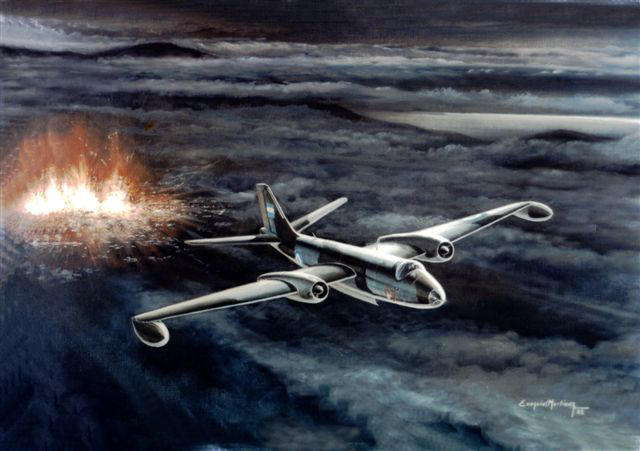 OF
1273: call sign HUINCA. In this case the bomb load was reduced to 3 per plane.
B-108 (Mj Chevalier / 1st Lt
Lozano), B-105
(Capt. Bertoldi / 1st Lt Reyes),
B-109 (Capt Garcia Puebla / 1st Lt
Segat). B-105 had to return, as one of the fuel tanks was not transferring its
contents to the engines. Segat tells some details about the mission: after
adopting a high – low profile they entered clouds and they could not see the sky
or the sea. He was calling out the directions to Garcia Puebla “to the right…to
the left…higher, lower, not so much…” They could see nothing outside. They were
to the South of Soledad Is. (East Falkland) and they turned north to start their
bombing run. The radar altimeter, showing 50 meters, started to give different
readings. This meant that they were now flying over ground. He kept on asking
his pilot if he was able to see something outside of the plane but the answer
was always negative. It was getting even darker! Suddenly Garcia Puebla said: “I
can see a white shadow ahead” to which Segat shouted back: “Climb! Climb!” It
was Kent Mount. The Gs pushed them against the seats. The radar altimeter was
shoving the climb and the presence of the mount just ahead of them, all covered
in snow. They opened the bomb bay doors and dropped their load. The plane shook
with the explosions and they could see the red sky behind. Now they were 1,000
ft high and therefore they were vulnerable. They dove in the middle of the night
to 60 meters and then Segat told Garcia Puebla to steer 030 to return to their
base. The radar in Puerto Argentino was tracking the area but was not able to
communicate directly wit the Canberras. Two minutes after their attack the radar
tried to tell them that there were Harriers after them but there was no direct
contact. In such a desperate situation Puerto Argentino called the continent
that in turn thru Rio Gallegos managed to contact the Canberras. Andy McHarg
from HMS Hermes had been launched and vectored in order to chase the Canberras.
Garcia Puebla saw a missile to their right and told his navigator: “Drop the
chaff!” Segat dropped flares and chaff at different intervals. The Canberra crew
felt an explosion behind them which it is believed was the explosion of the
surface-air missile that had been lured by the anti missile measures. By now
McHarg was really close to the Canberras. His fuel situation, though, was
critical having flown very far away from his mother ship. He managed to identify
the Canberras visually (he was now only 4 miles behind).
When the explosion happened the Canberra dropped their
wing tip tanks and accelerated. McHarg saw the enemy dropping the tanks and
pulling away but was not able to continue with the chase and returned to HMS
Hermes. (He does not mention any explosion behind the bomber) The Canberra
reached their height for their return leg and afterwards returned to the base
safely.
OF
1273: call sign HUINCA. In this case the bomb load was reduced to 3 per plane.
B-108 (Mj Chevalier / 1st Lt
Lozano), B-105
(Capt. Bertoldi / 1st Lt Reyes),
B-109 (Capt Garcia Puebla / 1st Lt
Segat). B-105 had to return, as one of the fuel tanks was not transferring its
contents to the engines. Segat tells some details about the mission: after
adopting a high – low profile they entered clouds and they could not see the sky
or the sea. He was calling out the directions to Garcia Puebla “to the right…to
the left…higher, lower, not so much…” They could see nothing outside. They were
to the South of Soledad Is. (East Falkland) and they turned north to start their
bombing run. The radar altimeter, showing 50 meters, started to give different
readings. This meant that they were now flying over ground. He kept on asking
his pilot if he was able to see something outside of the plane but the answer
was always negative. It was getting even darker! Suddenly Garcia Puebla said: “I
can see a white shadow ahead” to which Segat shouted back: “Climb! Climb!” It
was Kent Mount. The Gs pushed them against the seats. The radar altimeter was
shoving the climb and the presence of the mount just ahead of them, all covered
in snow. They opened the bomb bay doors and dropped their load. The plane shook
with the explosions and they could see the red sky behind. Now they were 1,000
ft high and therefore they were vulnerable. They dove in the middle of the night
to 60 meters and then Segat told Garcia Puebla to steer 030 to return to their
base. The radar in Puerto Argentino was tracking the area but was not able to
communicate directly wit the Canberras. Two minutes after their attack the radar
tried to tell them that there were Harriers after them but there was no direct
contact. In such a desperate situation Puerto Argentino called the continent
that in turn thru Rio Gallegos managed to contact the Canberras. Andy McHarg
from HMS Hermes had been launched and vectored in order to chase the Canberras.
Garcia Puebla saw a missile to their right and told his navigator: “Drop the
chaff!” Segat dropped flares and chaff at different intervals. The Canberra crew
felt an explosion behind them which it is believed was the explosion of the
surface-air missile that had been lured by the anti missile measures. By now
McHarg was really close to the Canberras. His fuel situation, though, was
critical having flown very far away from his mother ship. He managed to identify
the Canberras visually (he was now only 4 miles behind).
When the explosion happened the Canberra dropped their
wing tip tanks and accelerated. McHarg saw the enemy dropping the tanks and
pulling away but was not able to continue with the chase and returned to HMS
Hermes. (He does not mention any explosion behind the bomber) The Canberra
reached their height for their return leg and afterwards returned to the base
safely.
June 4th
OF
1276: Call sign
June 8th
The Canberras flew one of the most controversial missions. They were based for a
day in Mar del Plata and from there they took off in the afternoon.
600 miles away from the Argentine coast the Liberian
tanker Hercules it was identified as a potential supply ship for the British
Task Force by C-130 TC-68. The empty 220,000 tons super tanker was on its way to
Alaska to get another load
 of crude.
According to the captain of the ship some jet bombers (the Canberras?) dropped 8
bombs, one of which hit the ship but did not explode. The ship sailed to Rio de
Janeiro (Brazil) in order to get the bomb defused but on July 20th
the ship was sunk in front of the Brazilian coast to claim the money from the
insurance. The Argentine Air Force denied that the attack ever happened. The
planes allegedly involved were B-102, B-105 (Chevalier / Pagano), B-108 and
B-109 and it is believed that they carried 2 x Mk17 bombs under their wings. The
shipping company sued the Argentine Air Force in the US Supreme Court but the
case was dismissed. B-105 carried the kill mark of a ship on her nose for a
while.
of crude.
According to the captain of the ship some jet bombers (the Canberras?) dropped 8
bombs, one of which hit the ship but did not explode. The ship sailed to Rio de
Janeiro (Brazil) in order to get the bomb defused but on July 20th
the ship was sunk in front of the Brazilian coast to claim the money from the
insurance. The Argentine Air Force denied that the attack ever happened. The
planes allegedly involved were B-102, B-105 (Chevalier / Pagano), B-108 and
B-109 and it is believed that they carried 2 x Mk17 bombs under their wings. The
shipping company sued the Argentine Air Force in the US Supreme Court but the
case was dismissed. B-105 carried the kill mark of a ship on her nose for a
while.
June 10th
OF
1309 with call sign
June 12th
OF 1310 call sign TAURO. B-111 (Mj Vivas / 1st
Lt Rocco), B-105
(Capt. Pastran / Capt Casado). They flew low over the sea towards their target.
When they turned to reach the area West of Puerto Argentino (Stanley) they
dropped their wing tip tanks but only one the left ones did in each plane and
therefore this forced them to return to their base.
OF 1315 call sign ROMA.
B-105 (1st
Lt Rivolier / 1st Lt Annino), B-1xx
(1st Lt Heredia / 1st
lt Gerez). They reached the Southern part of San Carlos Sound but they
were forced to return as they saw some missiles being fired ahead of them, the
altimeter of the leader was not working and the low temperatures formed frost
over their hoods so they were not able to see outside.
OF 1316 call sign BERLIN. B-104 (Capt Martinez Villada / 1st
Lt Pagano), B-102 (Capt Garcia Puebla / 1st
Lt Segat). The leader returned with issues with the fuel system and Garcia
Puebla continued to the target alone. Though B-105 was not involved in this
attack it is a very interesting one so I am going to go thru it using Garcia
Puebla’s report.
Feeling lonely after loosing their leader due to their mechanical issue they
continued with the mission. Their target was close to the Argentine positions
and they were concerned about hitting them by mistake. They started to descend
and their prayed an Our Father asking the Lord to allow them to get to their
target and if possible to hit it. Now flying very low they flew in and out of
clouds and rain with cero visibility. Using their radar they were able to turn
towards their target. They checked their remaining fuel and found out that it
was lower than what it should so they reduced their speed which would allow them
to get to the target and back to base but would also make them more vulnerable
to the enemy anti aircraft fire. When the clouds broke they could see enemy
ships on both sides! They further lowered their height and their altimeter was
reading cero. Garcia Puebla was keeping his height using the reflection of the
moon on the surface of the sea. He changed the direction in order to try to
minimize their exposure to the enemy frigates flying in the middle of them with
each ship 8 miles to each side. They were finally able to leave them behind.
Segat started to doubt his navigation equipment and that could be the
explanation of the higher than expected fuel consumption and the presence of the
enemy ships. Accepting Segat’s comment meant failure and suddenly Garcia Puebla
was inundated by a tranquil feeling and told his navigator not to worry as he
was sure that they were going to be able to hit their target. Segat answered
that he believed him though all evidence was against them! With their cockpit
and instruments lights off to improve his night vision, flying in and out of
rain in the middle of the night they were lost. Suddenly there was a very
distant light shining low to their left. It could be either a star or a fire. It
would be their last chance to find the islands. One minute later they realized
it was a fire. It was Kent Mount. He exclaimed: We’ve got them!
He called the radar in Puerto Argentino (Stanley) but received no answer. They
started to see some of the shapes of the island in the middle of the dark when,
suddenly, there were lots of lights ahead and to their left. They had turned on
all the lights in the town! With that fundamental help Garcia Puebla was able to
pinpoint his position and the target that was located between the town and Kent
Mount. He climbed slightly to start his bombing run and then avoid the hills
behind the target. At that moment the radar came alive warning them: “Message to
the plane that is arriving form the North, there are 2 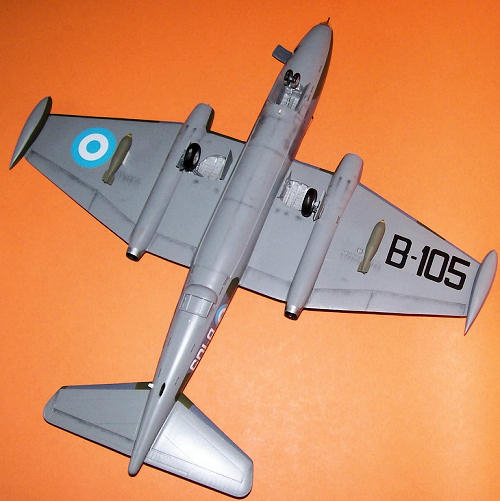 they are hot
on us!” Garcia Puebla accelerated to maximum speed and was about to eject his
wing tip tanks to improve his escape speed when he remembered that there a few
left in the base so he decided to keep them. He had two chances: to eject them
and disobey his orders or to keep on flying fast but risking the plane due to
the structural damage or lack of fuel. He decided to reduce his speed to 380 kt
to save fuel. When he did this he though: “I am giving too much advantage to the
British!” His eyes were jumping from the water to his tail and back to the sea.
He was also grabbing his top ejection handle when looking forward but had to let
it go when looking behind. Still flying low they had two options: either fly low
over San Carlos risking being shot down by the Harrier or start to climb to save
fuel. He picked the second option while Segat was telling him how many miles
they had flown since they had left their target. With this he was wondering how
much more would the Harriers try to chase them. Thirty miles from their target
Garcia Puebla started to climb while he said: “Well my friend, let it be God’s
will!” At that moment, the entire cockpit was lit and they heard a noise. He
thought it was the end but then realized that it was Saint Elmo’s fire. Minutes
run very slowly. Eighty miles. Still not caught…. it seemed unbelievable. Garcia
Puebla exclaimed that he believed that they were going to make it but Segat told
him that they were lost, as his navigation equipment was not reading.
Now they were flying at 40,000 ft and their only chance
was for the radars on the continent to find them as they radio stations had
lowered their transmissions and they were unable to get a bearing using them.
Their alternative was to eject in the middle of the night in the South Atlantic.
He started to call the radar in all the frequencies. Finally he was answered:
“Continue!” They shouted with happiness when the radar told them that they were
in their screens. Now that they were sure they were going to make it they
started to think about their families. When they landed they shouted: “Long live
the Fatherland!”, which was answered by the radar and the tower. It was 2 am on
June 13th. A message was received
from the islands thanking them for their effort and telling them that the
bombing had been very successful. With the happiness of having fulfilled their
mission they went to sleep.
they are hot
on us!” Garcia Puebla accelerated to maximum speed and was about to eject his
wing tip tanks to improve his escape speed when he remembered that there a few
left in the base so he decided to keep them. He had two chances: to eject them
and disobey his orders or to keep on flying fast but risking the plane due to
the structural damage or lack of fuel. He decided to reduce his speed to 380 kt
to save fuel. When he did this he though: “I am giving too much advantage to the
British!” His eyes were jumping from the water to his tail and back to the sea.
He was also grabbing his top ejection handle when looking forward but had to let
it go when looking behind. Still flying low they had two options: either fly low
over San Carlos risking being shot down by the Harrier or start to climb to save
fuel. He picked the second option while Segat was telling him how many miles
they had flown since they had left their target. With this he was wondering how
much more would the Harriers try to chase them. Thirty miles from their target
Garcia Puebla started to climb while he said: “Well my friend, let it be God’s
will!” At that moment, the entire cockpit was lit and they heard a noise. He
thought it was the end but then realized that it was Saint Elmo’s fire. Minutes
run very slowly. Eighty miles. Still not caught…. it seemed unbelievable. Garcia
Puebla exclaimed that he believed that they were going to make it but Segat told
him that they were lost, as his navigation equipment was not reading.
Now they were flying at 40,000 ft and their only chance
was for the radars on the continent to find them as they radio stations had
lowered their transmissions and they were unable to get a bearing using them.
Their alternative was to eject in the middle of the night in the South Atlantic.
He started to call the radar in all the frequencies. Finally he was answered:
“Continue!” They shouted with happiness when the radar told them that they were
in their screens. Now that they were sure they were going to make it they
started to think about their families. When they landed they shouted: “Long live
the Fatherland!”, which was answered by the radar and the tower. It was 2 am on
June 13th. A message was received
from the islands thanking them for their effort and telling them that the
bombing had been very successful. With the happiness of having fulfilled their
mission they went to sleep.
I
have transcribed this mission in detail to show the courage and will of this
Argentine Canberra crew.
June 13th
The last mission of the Canberras was flown around midnight on the 13th
when B-109 (Rivollier / Annino) and B-108 (Capt. Pastran and Casado) bombed Kent
Mount. A Sea Dart fired by HMS Exeter shot down the second plane, the same one
that had been damaged on May 1st. Pastran told Casado to eject but Casado
answered that his seat was not working (probably damaged by the explosion of the
missile in the belly of the plane). After loosing control of the plane Pastran
told his friend that he had no other option but to eject but he received no
answer from Casado. Pastran fell in the water, inflated his dinghy and managed
to get to the coast where he was captured by British troops. Casado crashed with
his plane thus becoming the last loss of the Argentine Air Force during the war.
Another significant effect of the action of the Canberras (and Hercules) during
the night was the couple of Canbelow missions that were carried out by HMS
Invincible on June 4th and 7th.
The idea was to position the carrier closer to the continent and shoot down with
the Harriers any enemy plane that tried to approach the Islands. But on the 4th
the heavy fog prevented the British from launching the Harriers even though
there were 2 Canberras on a bombing mission. On the 7th
a couple of Harriers were sent to chase a bogey (a C-130?) but this turned back
to the continent.
As a balance, the Squadron flew 33 successful sorties (meaning that they were
able to reach the target and drop their bombs). There were in total 236 flights
and B-111 and B102 were the planes flown the most. But in terms of successful
sorties the ones that flew the most were B-105 and B-108 (shot down during the
last mission as seen above). During these missions the Canberras dropped a grand
total of 38.6 MT of bombs with the loss of 3 crewmembers and one POW.
After the war
Their activities continued but gradually less hours were flown each year. A Bendix RDR 1400 radar was installed on B-101 (and used it during the war) and B-104 and B-107 after the war. It is believed that the asymmetrical configuration led to the accidents that destroyed the last two planes in 1982 and 1983 respectively. As a consequence this equipment was removed from B-101. The role of the planes switched from bombing to photography. Very few hours were flown in the ‘90s with B-102, B-105 and B-112 being removed from flying in 1998. There were now only 3 planes left (B-101, B-109, B-111) that kept on flying training missions and air shows. The final official flight of the Canberras in Argentina took place on April 5th 2000.
| THE KIT |
This is the multimedia CA kit, launched just shortly before the Airfix one. Should I have been more patience I would have had a better experience…Basically the main parts are injected plastic and the details (like cockpit and wheel wells are cast in resin with excellent details)
| CONSTRUCTION |
First and foremost I spend several ours sanding out the pouring stubs of the
resin parts. Once they were cleaned I painted the cockpit and all the main
components in dark gray. Details where highlighted using pictures from books and
the excellent
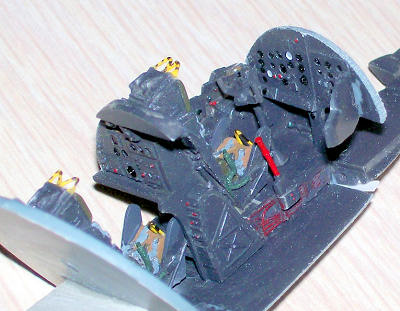 Argentine
website dedicated to the Canberras (http://canberrasargentinos.com).
The instructions, though very good, are not good enough (at least for me!) to
put together all the cockpit parts. It took me lots of testing, measuring,
looking at pictures until I got it right…though I ended up with a step that I
covered with white plastic that was later on painted in dark gray.
Argentine
website dedicated to the Canberras (http://canberrasargentinos.com).
The instructions, though very good, are not good enough (at least for me!) to
put together all the cockpit parts. It took me lots of testing, measuring,
looking at pictures until I got it right…though I ended up with a step that I
covered with white plastic that was later on painted in dark gray.
I
moved to the wings to have them ready for the tests to determine the weight
required for the nose. I thinned out the trailing edge and had to add a little
piece of plasticard to improve the fit of the frontal part of the engines.
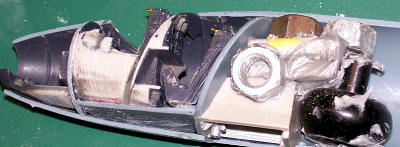
In order to close the fuselage and add the weight (not stipulated in the
instructions) I assembled the main components using masking tape and stood the
plane on some pieces of plastic. I kept on opening and closing the fuselage
halves while adding more weight. There are 3 windows for the navigator on the
Argentine version. I opened up 4…more about this later…once satisfied I glued
the fuselage together.
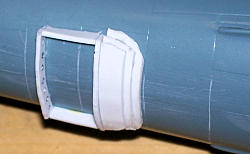
Once the
fuselage union was filled and sanded I started to work on the flares/chaff
dispenser. Using some pictures and checking references in the Internet, I came
up with the dimensions… that I got wrong. My dispenser is probably 50% larger
than what it should be…
Using plasticard I made the main frame and the frontal part was made up of
layers of the same material that, once dry, was covered with 2-part epoxy. I
used putty to cover the imperfections.
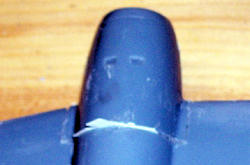
Next was the nose cone. The fuselage had to be sanded so there was a smooth
union of the clear and gray parts.
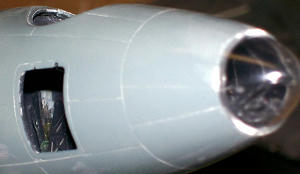
I
glued the windows and used some acrylic paste to improve the union of the clear
parts with the fuselage.
Then I found that there are two little intakes on each side of the nose that are
not described in the instructions…and there are no parts to make them. So I took
the middle part of the 40 mm guns of a Hurricane and sanded it to achieve the
correct shape. Same process was done for the other side.
The ADF Bendix DFA-73 was made up with plasticard and glued behind the cockpit.
Of course scribing had to be done in several areas after all the sanding I had
to do.
I
could finally say that the fuselage, the most difficult part of the kit, was
ready!
With the main parts ready I glued them together. There are 2 “spars” to improve
the unions between fuselage and wings. In fact, there are 2 parts in the kit…but
I did no see them so I used the plastic sprue and cut it and sand it to shape
and to make it fit in the wholes provided (that had to be anyway enlarged with a
knife as they were not properly opened due to the fact that it is a limited
production kit and therefore the plastic parts have several imperfections)
Some more putty and sanding to achieve a decent wing to fuselage joint.
There was not problem attaching the horizontal tail surfaces…except that to get
the correct dihedral I had to keep the tips supported in place until the glue
was dry the following day.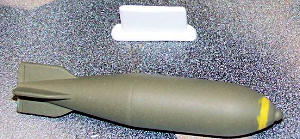
In terms of external armament I scratchbuilt the pylons using plasticard and the
Mk17 bombs were taken from the spares (Hobbycraft). To these I had to modify the
fins to represent the ones used on the Canberras.
The navigation
lights (oversized) were added to the wings and sanded down to achieve a decent
union. I glued the wing tip tanks (many minutes of research in books and
Internet to place them properly)
Finally I was ready to paint the kit.
| COLORS & MARKINGS |
The undersides were first painted with Model Master Acryl 4757 Medium Sea Grey.
Once I masked the belly of the plane I applied the dark gray to the top surface
(MM 4754) and then with a sharp delimitation line I painted the green areas (MM
4726 – RAF Dark Green). Considering that the large Argentine roundel would hide
some imperfection on the green on the top left wing, I left it like that…more
about this later…!
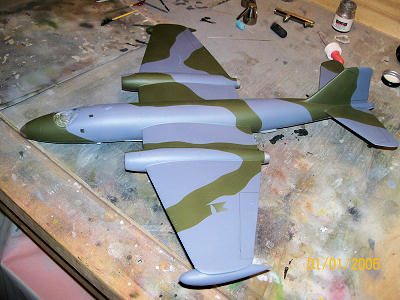
I
sanded some black pastel and with a brush applied it to the moveable surfaces,
doors, access hatches, exhausts and other dirty areas as seen in several
pictures of the Argentine bombers.
The kit was given several heavy hands of Future and was ready for the decals.
But first I glued the landing gear.
The decals supplied by CA are not good at all as the shape of the letters is
wrong and there are no stencils in Spanish. The Aztec set, in this respect, is
much better…but not perfect. Decal quality is very good but there are mistakes
(example the red glove close to the crew access door is mirrored) and the
instructions are not as good as they could be.
The other big interrogation mark is the “No walk” yellow stencil on the wings.
When the planes arrived in Argentina they had them painted in yellow but it’d
seem by 1982 they were not there anymore (same applies to other words and signs)
When applying the “Fuerza Aérea Argentina” on the right side of the fuselage I
realized that…there was no square window for the navigator on this side! I
already had most of the other decals glued in that area! So with lots of care I
covered the window with putty, sanded it and painted it back after I used Post
It ™ papers to mask the deca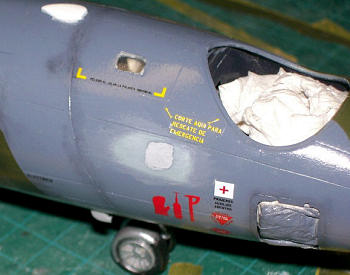 ls
without fearing ripping them off when removing the masking tape. To my dismay it
looked like the color was not the same as the original. I tried several times,
removed the paint, did it again, and double-checked the colors…finally it was
close but not enough. I could clearly see a difference in the tone, the new
paint being lighter. What the h…! I was fed up and decided to leave it like
this. The following night I gave that area a light coat of Future and was able
to add the “FAA” decal.
ls
without fearing ripping them off when removing the masking tape. To my dismay it
looked like the color was not the same as the original. I tried several times,
removed the paint, did it again, and double-checked the colors…finally it was
close but not enough. I could clearly see a difference in the tone, the new
paint being lighter. What the h…! I was fed up and decided to leave it like
this. The following night I gave that area a light coat of Future and was able
to add the “FAA” decal.
Luckily, now that the time has passed, it looks like that the paint has “cured”
and got as dark as the original one. Phew!
The other error was the green area on the left wing seen above. It turned out that the roundel was not placed on top of the error! So I sanded the Future, masked the rest of the plane and corrected the green profile. Another hand of Future to the area and now I was able to transfer the huge roundel.
| FINAL CONSTRUCTION |
The following things were scratch built and added:
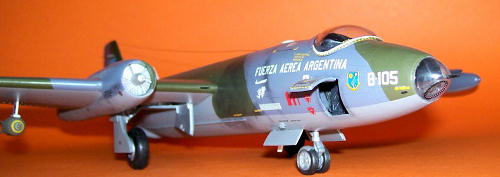 2
little lights (one on top of the fuselage behind the VHF antenna) and the
other one behind the chaff dispenser
2
little lights (one on top of the fuselage behind the VHF antenna) and the
other one behind the chaff dispenser
And finally the canopy! But before that, I had to add some extra weight inside
the cockpit because either due to the extra weight of the chaff dispenser or a
bad dry fit/test, the plane was a tail sitter. One lead square was added on the
wall beside the navigator…just where the window had been…and another one against
the rear bulkhead. Both were painted dark gray before inserted them with long
tweezers.
With this issue fixed it was done! Exactly 3 months working almost every single night for at least 2 hours…
| CONCLUSIONS |
Hmmm…Good kit, difficult to put together. Lots of scratch building required. Not
entirely satisfied with the results (chaff dispenser being too large), joint of
canopy/fuselage not perfect…but a nice representation of an Argentine Canberra.
| REFERENCES |
Dios y los Halcones (Pablo Carballo)
Halcones de Malvinas (Pablo Carballo)
Historia Oficial de la Fuerza Aerea, Volumen 6 (Malvinas), Book 1 and 2
Guerra Aérea en las Malvinas (Benigno Andrada)
Falklands Air War
(Hobson)
EC, Pablo Carballo
September 2011
If you would like your product reviewed fairly and fairly quickly, please contact the editor or see other details in the Note to Contributors.